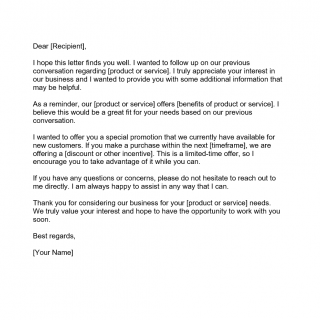Follow-up sales letter
A follow-up sales letter is a document used to remind customers of a previous interaction and encourage them to take further action. The main purpose of this form is to persuade potential customers to make a purchase or take another action that benefits the business.
The form typically consists of a letter written in a professional and persuasive tone, addressing the recipient by name and referencing previous interactions. Important fields to consider when compiling the form include the recipient's contact information, details of previous interactions, and the desired action the business would like the recipient to take.
Parties involved in the follow-up sales letter include the business and the recipient. It is important to consider the recipient's needs and preferences when crafting the letter in order to increase the chances of a positive response.
Data required when compiling the form includes the recipient's contact information, details of previous interactions, and information about the product or service being offered. Additional documents that may be attached include product brochures or pricing information.
Application examples and practice and use cases for the follow-up sales letter include sending it to potential customers who have expressed interest in a product or service but have not yet made a purchase, as well as sending it to existing customers to encourage repeat business.
Sample:
Dear [Recipient],
I hope this letter finds you well. I wanted to follow up on our previous conversation regarding [product or service]. I truly appreciate your interest in our business and I wanted to provide you with some additional information that may be helpful.
As a reminder, our [product or service] offers [benefits of product or service]. I believe this would be a great fit for your needs based on our previous conversation.
I wanted to offer you a special promotion that we currently have available for new customers. If you make a purchase within the next [timeframe], we are offering a [discount or other incentive]. This is a limited-time offer, so I encourage you to take advantage of it while you can.
If you have any questions or concerns, please do not hesitate to reach out to me directly. I am always happy to assist in any way that I can.
Thank you for considering our business for your [product or service] needs. We truly value your interest and hope to have the opportunity to work with you soon.
Best regards,
[Your Name]
Benefits of the follow-up sales letter include increased customer engagement and sales, while risks and challenges may include the possibility of annoying or alienating the recipient if the letter is not well-crafted.
Related and alternative forms include email or phone call follow-ups, as well as more formal proposals or contracts. The main difference between a follow-up sales letter and these other forms is the tone and level of formality.
The follow-up sales letter can influence the future of the participants by encouraging continued engagement with the business and promoting customer loyalty. The form is typically submitted via mail or email and may be stored in the recipient's records or the business's customer management system.

